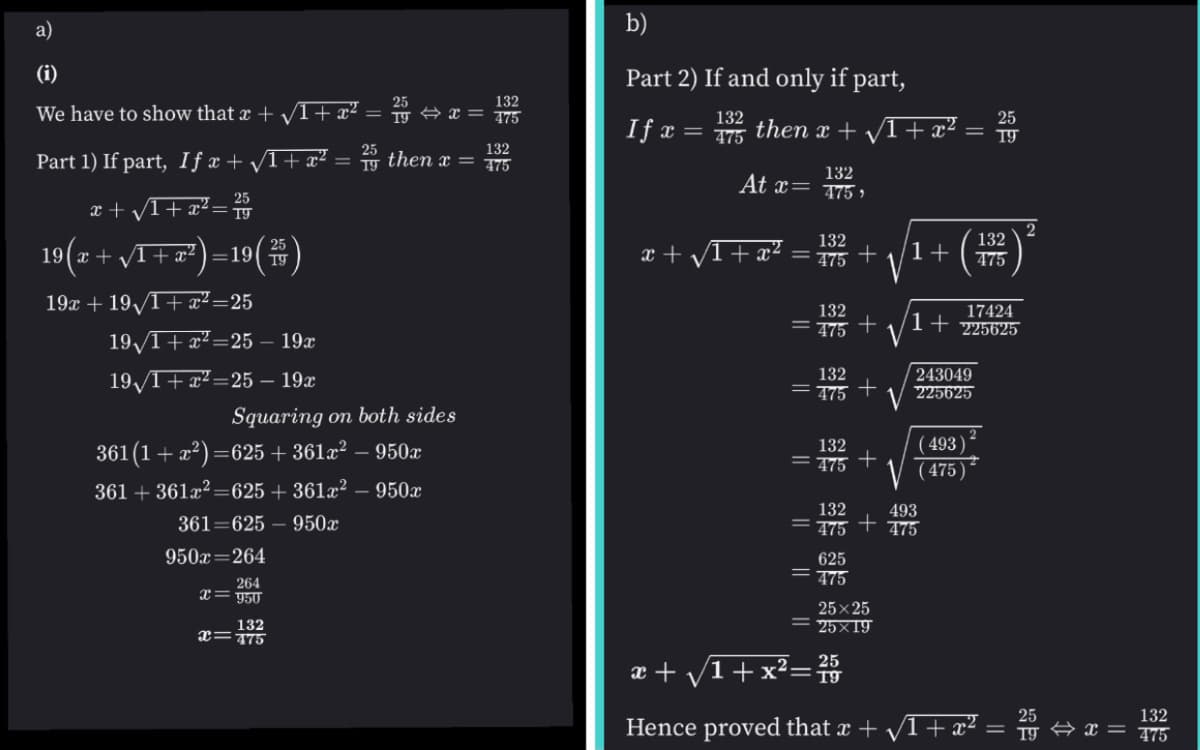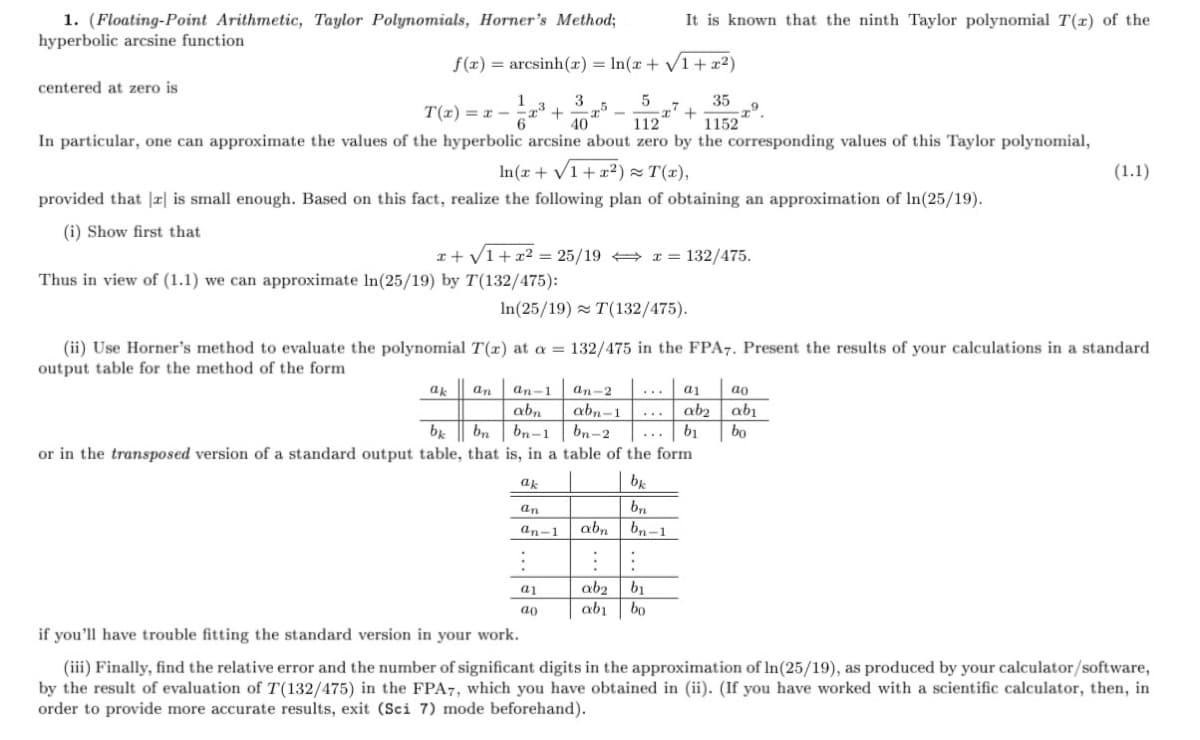(ii) Use Horner's method to evaluate the polynomial T(r) at a = 132/475 in the FPA7. Present the results of your calculations in a standard output table for the method of the form ak an an-1 an-2 ... a1 ao abn bn-1 abn-1 bn-2 ab2 abı bo ... bk bn b1 ... or in the transposed version of a standard output table, that is, in a table of the form ak an bn an-1 abn bn-1 : a1 ab2 b1 ao abi bo if you'll have trouble fitting the standard version in your work. (iii) Finally, find the relative error and the number of significant digits in the approximation of In(25/19), as produced by your calculator/software, by the result of evaluation of T(132/475) in the FPA7, which you have obtained in (ii). (If you have worked with a scientific calculator, then, in order to provide more accurate results, exit (Sci 7) mode beforehand).
(ii) Use Horner's method to evaluate the polynomial T(r) at a = 132/475 in the FPA7. Present the results of your calculations in a standard output table for the method of the form ak an an-1 an-2 ... a1 ao abn bn-1 abn-1 bn-2 ab2 abı bo ... bk bn b1 ... or in the transposed version of a standard output table, that is, in a table of the form ak an bn an-1 abn bn-1 : a1 ab2 b1 ao abi bo if you'll have trouble fitting the standard version in your work. (iii) Finally, find the relative error and the number of significant digits in the approximation of In(25/19), as produced by your calculator/software, by the result of evaluation of T(132/475) in the FPA7, which you have obtained in (ii). (If you have worked with a scientific calculator, then, in order to provide more accurate results, exit (Sci 7) mode beforehand).
Algebra for College Students
10th Edition
ISBN:9781285195780
Author:Jerome E. Kaufmann, Karen L. Schwitters
Publisher:Jerome E. Kaufmann, Karen L. Schwitters
Chapter9: Polynomial And Rational Functions
Section9.4: Graphing Polynomial Functions
Problem 47PS
Related questions
Question
100%
Numerical analysis
Q1 part i is answered I only need part ii and iii thanks.

Transcribed Image Text:a)
b)
(i)
Part 2) If and only if part,
25
= 19 A x = 775
132
We have to show that x + I+x²
132
25
If x
then x + VI+ x² =
475
25
132
Part 1) If part, If x + /1+ x² = then x = 5
132
At x= 75 »
25
x + V1+ x? = 1
132
132
19(a + vI+ x²) =19(#)
25
x + /1+ x²)=19( 19
x + /1+æ?
475 +
1+
475
19x + 19/T+ x²=25
17424
225625
132
= 75 +
1
19/T+x²=25 – 19x
243049
225625
132
191+x?=25 – 19x
= 775 +
Squaring on both sides
( 493)
361 (1+ x2) =625 + 361x² – 950x
132
= 775 +
V (475)
361 + 361x² =625 + 361x² – 950x
132
493
361=625 – 950x
475 † 475
950x=264
625
475
264
x= 950
25x 25
= 25×19
132
x=175
æ + /1+x²=
Hence proved that x + /1+ æ² =
132
475
A x =
||

Transcribed Image Text:1. (Floating-Point Arithmetic, Taylor Polynomials, Horner's Method;
hyperbolic arcsine function
It is known that the ninth Taylor polynomial T(x) of the
f(x) = arcsinh(x)= ln(x + 1+ x²)
centered at zero is
5
-x' +
112
35
1
T(x) = x -
3
40
1152
In particular, one can approximate the values of the hyperbolic arcsine about zero by the corresponding values of this Taylor polynomial,
In(x + V1+ x²) = T(x),
(1.1)
provided that |x| is small enough. Based on this fact, realize the following plan of obtaining an approximation of In(25/19).
(i) Show first that
x+ V1+x2 = 25/19 + I = 132/475.
Thus in view of (1.1) we can approximate In(25/19) by T(132/475):
In(25/19) T(132/475).
(ii) Use Horner's method to evaluate the polynomial T(x) at a = 132/475 in the FPA7. Present the results of your calculations in a standard
output table for the method of the form
ak
an
an-1
an-2
...
a1
ao
abn
bn-1
bn
ab2 abı
bo
b1
abn-1
...
bn-2
...
or in the transposed version of a standard output table, that is, in a table of the form
ak
be
an
bn
an-1
abn
bn-1
ab2
abi
bo
a1
b1
ao
if you'll have trouble fitting the standard version in your work.
(iii) Finally, find the relative error and the number of significant digits in the approximation of In(25/19), as produced by your calculator/software,
by the result of evaluation of T(132/475) in the FPA7, which you have obtained in (ii). (If you have worked with a scientific calculator, then, in
order to provide more accurate results, exit (Sci 7) mode beforehand).
Expert Solution
This question has been solved!
Explore an expertly crafted, step-by-step solution for a thorough understanding of key concepts.
Step by step
Solved in 2 steps

Knowledge Booster
Learn more about
Need a deep-dive on the concept behind this application? Look no further. Learn more about this topic, advanced-math and related others by exploring similar questions and additional content below.Recommended textbooks for you

Algebra for College Students
Algebra
ISBN:
9781285195780
Author:
Jerome E. Kaufmann, Karen L. Schwitters
Publisher:
Cengage Learning

Algebra & Trigonometry with Analytic Geometry
Algebra
ISBN:
9781133382119
Author:
Swokowski
Publisher:
Cengage

Algebra for College Students
Algebra
ISBN:
9781285195780
Author:
Jerome E. Kaufmann, Karen L. Schwitters
Publisher:
Cengage Learning

Algebra & Trigonometry with Analytic Geometry
Algebra
ISBN:
9781133382119
Author:
Swokowski
Publisher:
Cengage